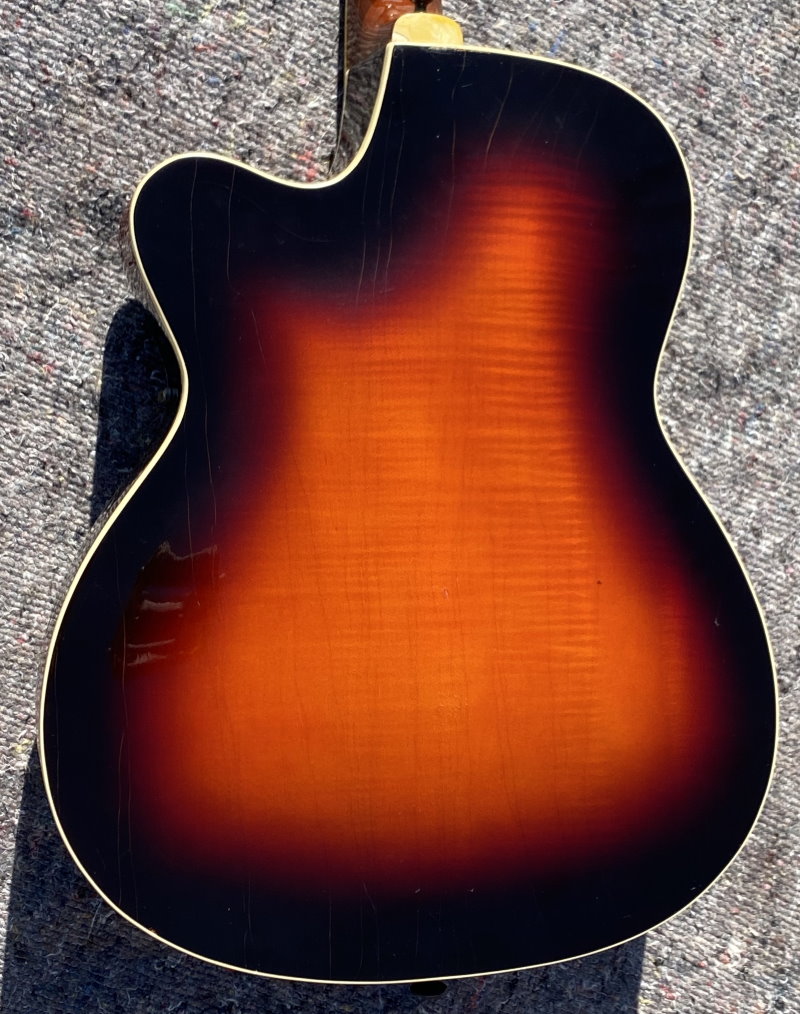
















Mid 60's HOYER PLAYBOY Sunburst, 2 Pickups, Vibratocomes in Professional Hard Gig Bag case code VA111
Very nice and very rare model, solid ebony fingerboard, 3 piece neck, Spruce Top, back and side flamed maple. Two Volum Two Tone and Master Volum. Very beautiful headstock and fretboard inlay. Solid structure guitar, totally original, good frets, all electronics working well. Classic lines on the original finish the wood is NOT broken. The basis of the features corresponds to the "55 Thinline" model
The origins of HOYER reach back over 140 years – back to the craftsmanship of Franz Hoyer in his workshop in Bohemia. It was his ambition to create instruments that aid the musician, that allow the musician to become prepossesed by their passion for music.
The history of the HOYER guitar brand began in 1874, when Franz Hoyer, son of an old German luthier family, opened his own workshop in Schönbach/Egerland (today Czech Republic). Schönbach was an important part of the European musical instrument production at that time. After making lutes and zithers in the beginning, HOYER changed more and more to classic and folk guitars. Later, the prospering company was continued by his son Joseph Hoyer.
In 1945, the family had to leave Schönbach (now Czech Republic) and settled at Tennelohe near Erlangen in Germany. Erlangen was an area where many instrument and accessory makers who had come from Egerland during this time settled. Arnold Hoyer, Joseph Hoyer’s son, reorganised the HOYER company and after a short time the brand became well-known for it’s good quality.
HOYER was one of first German guitar companies to print a brochure after the second world war in 1948. The arch-top models ‘Herr im Frack’ and ‘Solist’ were very popular professional instruments during this period. Both models are now collectors items with cult status.


1874
The history of the HOYER guitar brand began in 1874, when Franz Hoyer, son of an
old German luthier family, opened his own workshop in Schönbach/Egerland (today
Czech Repulic). Schönbach was an important part of the European musical
instrument production at that time. After making lutes and zithers in the
beginning, HOYER changed more and more to classic and folk guitars. Later, the
prospering company was continued by his son Joseph Hoyer.
1945
In 1945, the family had to leave Schönbach (now Czech Republic) and settled at
Tennelohe near Erlangen in Germany. Erlangen was an area where many instrument
and accessory makers who had come from Egerland during this time settled.
Arnold Hoyer, Joseph Hoyer’s son, reorganised the HOYER company and after a
short time the brand became well-known for it’s good quality.
1948
HOYER was one of first German guitar companies to print a brochure after the
second world war in 1948 (see right). The arch-top models ‘Herr im Frack’ and
‘Solist’ were very popular professional instruments during this period. Both
models are now collectors items with cult status.
1950’s
After the great epoch of the acoustic archtop guitars in the 50’s, instruments
were more frequently equipped with pickups, followed by semi-acoustic models,
and by the end of the 50‘s, by solid guitars.
1960’s
After Arnold Hoyer’s passing in 1967 his son Walter A. Hoyer took the lead of
the HOYER company, which focused more and more on Electric- and Folk Guitars.
During this period the quality of the HOYER Guitars achieved high standards.
This was a period of not only many attractive and popular models, but also some
very exotic creations. An extreme and rare example was the ‘Foldaxe’, a guitar
with a fold-away neck!
1970’s
In 1977 Walter A. Hoyer left the company. With famous and qualified staff, for
example the well-known luthier Walter Krahl, the new HOYER owners had good
success with guitar models of highest quality levels, like the legendary ‘Black
Lady’, the ‘Eagle’ the ‘Taurus’ Bass and some USA influenced styles, all
equipped with through-necks and branded pickups and hardware.
1980’s
The HOYER company stopped it’s production in autumn, 1987.

After Arnold Hoyer’s passing in 1967 his son Walter A. Hoyer took the lead of the HOYER company, which focused more and more on Electric- and Folk Guitars. During this period the quality of the HOYER Guitars achieved high standards. This was a period of not only many attractive and popular models, but also some very exotic creations.